
Super-Giant Black Hole Baffles Scientists (ABC News)
– Super-Giant Black Hole Baffles Scientists (ABC News, Nov 29, 2012):
You would probably not enjoy the galaxy NGC 1277. Never mind that it’s far – 220 million light-years away in the constellation Perseus. The problem is that at its center is a giant, giant black hole, 17 billion times as massive as our sun, so big that scientists calculate it makes up 59 percent of the mass of the galaxy’s disc.
Astrophysicists have long believed that there’s a black hole at the center of our Milky Way, but it probably accounts for something like 0.1 percent of the galaxy’s center. The one in NGC 1277, scientists report in today’s edition of the journal Nature, is the second largest they’ve ever observed, and it upends what they thought about how galaxies form.
Black holes, as you’ll recall, are objects in space so massive that their gravity consumes everything around them – stars, planets, matter, energy, even light. Earthly scientists can only observe their effect on the space around them, not see them directly. Be grateful we’re not close to one. They’re actually useful to astrophysicists in explaining the nice spiral shape of many galaxies – you need something massive in the middle for the stars to circle – but NGC 1277 is an extreme.
Read moreSuper-Giant Black Hole Baffles Scientists (ABC News)



